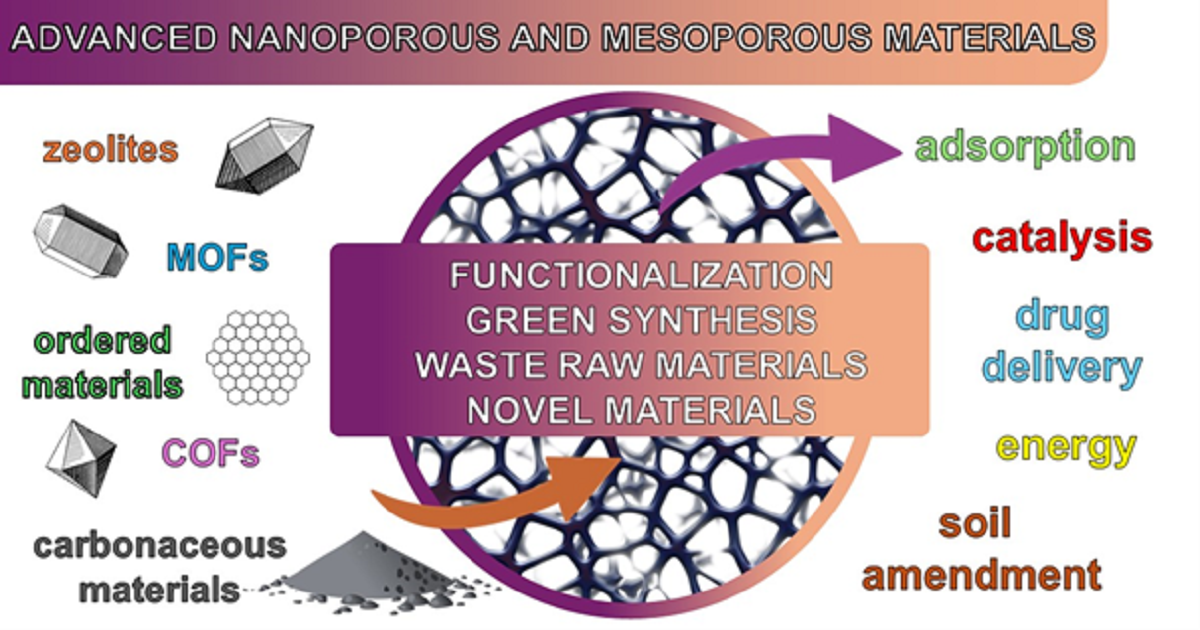Advanced Nanoporous and Mesoporous Materials
A special issue of Materials (ISSN 1996-1944). This special issue belongs to the section "Porous Materials".
Deadline for manuscript submissions: 31 October 2025 | Viewed by 14888

Special Issue Editors
Interests: adsorption; heterogenous catalysis; zeolite; ion-exchange; activated carbon; biochar; mesoporous silica; MOFs
Interests: heterogenous catalysis; zeolites; soot combustion; SCR, cryptomelane; mesoporous silica
Interests: biomass waste reuse; biomass energy technology; porous material preparation; liquid phase adsorption and interface research; biomass energy policy
Special Issues, Collections and Topics in MDPI journals
Special Issue Information
Dear Colleagues,
Nanoporous and mesoporous materials involve i.a. MOFs, COFs, zeolites, ordered mesoporous silicates, carbonaceous materials (activated carbons, biochars), which can find numerous applications owing to their unique properties – specified pore size distribution, high specific surface areas, and presence of functional groups. Their most important applications were found to be adsorption from both aqueous and gaseous media, heterogenous catalysis, gas separation, drug delivery, and soil amendment. Opportunity to use waste materials for their production and, so called “green synthesis” (more environmental friendly chemicals), allows to obtain a value added products with emerging applications in industry.
This special issue is aimed to gain a deeper knowledge on the latest findings of such materials and showing their potential applications and future perspectives. A broad range of nanoporous and mesoporous materials, showing their modifications, and utilization pathways are in the scope of the present Special Issue.
Dr. Jakub Mokrzycki
Dr. Monika Fedyna
Prof. Dr. Wen-Tien Tsai
Guest Editors
Manuscript Submission Information
Manuscripts should be submitted online at www.mdpi.com by registering and logging in to this website. Once you are registered, click here to go to the submission form. Manuscripts can be submitted until the deadline. All submissions that pass pre-check are peer-reviewed. Accepted papers will be published continuously in the journal (as soon as accepted) and will be listed together on the special issue website. Research articles, review articles as well as short communications are invited. For planned papers, a title and short abstract (about 100 words) can be sent to the Editorial Office for announcement on this website.
Submitted manuscripts should not have been published previously, nor be under consideration for publication elsewhere (except conference proceedings papers). All manuscripts are thoroughly refereed through a single-blind peer-review process. A guide for authors and other relevant information for submission of manuscripts is available on the Instructions for Authors page. Materials is an international peer-reviewed open access semimonthly journal published by MDPI.
Please visit the Instructions for Authors page before submitting a manuscript. The Article Processing Charge (APC) for publication in this open access journal is 2600 CHF (Swiss Francs). Submitted papers should be well formatted and use good English. Authors may use MDPI's English editing service prior to publication or during author revisions.
Keywords
- zeolite
- MOFs
- COFs
- ordered materials
- carbonaceous materials
- adsorption
- catalysis
- energy
Benefits of Publishing in a Special Issue
- Ease of navigation: Grouping papers by topic helps scholars navigate broad scope journals more efficiently.
- Greater discoverability: Special Issues support the reach and impact of scientific research. Articles in Special Issues are more discoverable and cited more frequently.
- Expansion of research network: Special Issues facilitate connections among authors, fostering scientific collaborations.
- External promotion: Articles in Special Issues are often promoted through the journal's social media, increasing their visibility.
- Reprint: MDPI Books provides the opportunity to republish successful Special Issues in book format, both online and in print.
Further information on MDPI's Special Issue policies can be found here.








